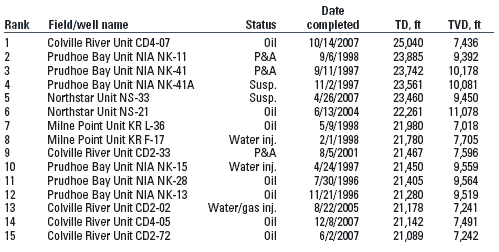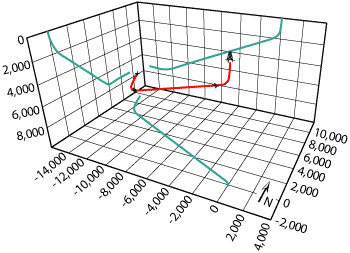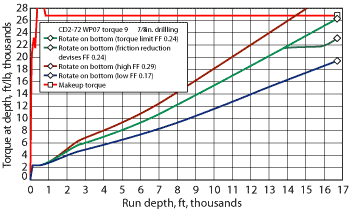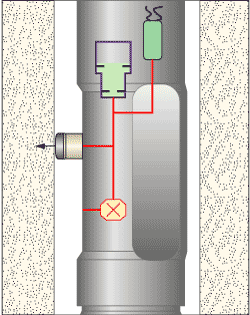Alpine Field team uses optimized drilling and three hole sizes to set a new depth/departure record.
Chip Alvord, Brian Noel and Liz Galiunas, ConocoPhillips Alaska, Inc.; Vern Johnson, Keith Holtzman and Jeff Sack, Halliburton Sperry Drilling Services; and Lee Smith, Halliburton Energy Services,Security DBS Drill Bits, Alaskan Energy Resources, Inc.
In one of the most remote and demanding drilling environments in the world-in the Alpine Development Field on the Western North Slope of Alaska-ConocoPhillips Alaska, Inc. and partner Anadarko continue to extend the reach of the small-bore well design using rotary steerable drilling assemblies. Refining drilling techniques and practices that have maximized reach and increased horizontal length since 2004 (World Oil, June 2007), the team has delivered four more horizontal wells using only three hole sizes, including a recent well exceeding 25,000-ft MD-a new Alaskan depth/departure record.
By building on previous experience while accumulating an extensive database of more than 100 wells, the team has been able to drill these new, complex wellbores with 4¾-in. small-bore Rotary Steerable System (RSS) tools in the horizontal production section, thus avoiding upsizing the entire well design.
However, it has required continuous optimizations in RSS and PDC bit design, torque and drag modeling, fluids, hydraulics and use of new logging tools to deliver these high-departure wells. And in an environment with little margin for error, Alpine team cooperation has proved essential to success.
Alpine Field is the westernmost oil-producing area on Alaska’s North Slope, Fig. 1. The field is located in the Colville River Delta where number, size and location of the gravel drill sites are strictly regulated. Since there is no road connecting Alpine to the other North Slope fields and drilling support infrastructure, access is very limited and quality planning is critical to successful drilling. Winter ice roads are built and used for three months to move in heavy equipment and supplies for a year’s worth of drilling. Aircraft provide access during the remaining nine months of the year.
 |
|
Fig. 1. ConocoPhillips is developing Alpine Field on Alaska’s North Slope in the Colville River Delta.
|
|
The drilling of 102 horizontal wells targeting a sandstone reservoir at 7,000-ft TVD was completed from 1999 to 2005. The well design consisted of three hole sections below a 16-in. conductor. The surface and intermediate holes are drilled and cased, and then a 6 1/8-in. diameter horizontal interval is drilled in the reservoir. Additional opportunity lies west of the initial development and permitting efforts are underway for a new gravel pad. Using RSS to drill the intermediate and production hole, the team has been able to push the reach of the slimhole well design and access peripheral targets to provide production today, Fig. 2. Alpine Field now holds five of the top 15 deepest wells completed in Alaska, Table 1.
 |
|
Fig. 2. RSS drilling in Alpine wells has pushed the reach of the slimhole well design and opened access to peripheral targets.
|
|
TABLE 1. Fifteen deepest wells completed in Alaska
|
 |
|
BACKGROUND
Introduction of 4 3/4-in. slimhole rotary steerable drilling tools at Alpine in 2004 has allowed increasingly longer and more complex horizontals to be drilled, with wells today exceeding 20,000-ft MD. Use of the RSS matching Sperry’s Geo-Pilot with an extended-gauge bit design from Security DBS has proven to be “best practice” technology for the job and, as of January 2007, has been used by this operator on more than 65 wells to drill more than 745,000 ft of hole.
In the first three years, 54 wells, averaging 12,657 ft in length, were drilled in an average of 15.44 days/10,000 ft using the system. The next two years saw a 17% increase in efficiency with wells that were 14% longer, on average, and improvements have continued. The recently drilled CD4-07 well established a new depth/departure record (11.8 days/10,000 ft) for Alaska at 25,040-ft MD (22,512-ft TVD).
With each accomplishment increased performance demands have come. Although the Alpine wells have grown more challenging both in length and complexity, the requirement to make changes as the program moves forward remains unchanged, e.g., no work stoppage. The team must be able to rapidly meet new drilling goals, while maintaining or improving safety performance.
To meet that requirement, the “Drill Team” approach empowers members to analyze drilling-related issues and optimize drilling operations through a coordinated service. Key components are supplied by service company rig site equipment with real-time and historical pressure-while-drilling, vibration, and Logging-While-Drilling (LWD) capabilities. This data is integrated with surface drilling parameters, drilling mud properties and the drilling technique needed to steer the well.
The optimization service supplies information needed to make detailed interpretations about hole-cleaning problems, drag issues and drillstring vibration downhole in specific formations. Using this process over time, the consistency of the drilling operation’s procedures and parameters, coupled with recording of lessons learned and iterative modeling, allowed predictable performance, ultimately enabling the record depth.
WELL TYPES
The standard hole sizes for the Alpine project have been 12¼-in. for surface, 8¾-in. for intermediate and 6 1/8-in. for laterals. These are completed with 9 5/8-in., L-80 40-lb/ft and 7-in. L-80 26-lb/ft casing. The laterals vary from barefoot completions to 4½-in., 12.6-lb/ft slotted liners. By contrast, the industry standard for these well profiles is 16-in. surface, 12¼-in. intermediate and 8½-in. laterals.
Within the Alpine team, and in this discussion, wells ending in 6 1/8-in. hole are referred to as “slim bore”; those ending in 6¾-in. hole are “small bore”; and those ending in 8½-in. hole are “big bore.” Staying with Alpine’s small-bore well design in CD2-72 and the record in CD4-07 provides an example of the challenges overcome and accomplishments made possible using the team approach, Figs. 3 and 4.
 |
|
Fig. 3. Well path of CD2-72.
|
|
 |
|
Fig. 4. Well path of CD4-07.
|
|
NEED FOR CHANGE
The intermediate hole section in Alpine wells can exceed 10,000 ft and is a key driver for increasing efficiencies. Modeling has shown that with the increased step-out and intermediate hole section length, stand pipe pressure using 4-in. drill pipe limited flowrates near the section’s TD.
To successfully drill higher departure wells, the team required 5-in. drill pipe to reduce frictional losses and allow for a higher flowrate near TD. The subsequent 6 1/8-in. hole section required 4-in. drill pipe.
Point-the-bit RSS made it possible to use 4-in. drill pipe for both the intermediate and the production hole sections, with constant rotation giving more effective hole cleaning and more consistent Equivalent Circulating Density (ECD) control. The resulting smooth, non-spiraled wellbore reduced the measured Torque and Drag (T&D) in both the intermediate hole section and lateral sections.
The reservoir pressure prediction for Well CD2-72 required a larger hole size than the 61/8-in. slim-bore well design would afford to maintain ECD below fracture gradient. The initial and most obvious solution was to upsize to the 8½-in. big-bore well design, which is more generally accepted by the industry for these wells. However, the solution well design was a small bore: 13 1/2-in. surface, 9 7/8-in. intermediate and 6¾-in. lateral design.
While the big bore well design did bring ECD relief, a limiting factor was identified through T&D analysis. Using friction factors established from previous offset wells, modeling for the big-bore design indicated that the torque limit for the 5-in. drill pipe would be exceeded, if system friction was not maintained to the lowest possible levels. Specifically, there would be only 0.03 friction factor points separating the lowest achievable friction factor and the torque limit friction factor.
In contrast, the 9 7/8-in. intermediate hole section of the 6¾-in. small-bore well design would allow for 0.07 friction-factor point separation between the lowest achievable friction factor and the torque-limit friction factor, Fig. 5. Furthermore, with the addition of mechanical friction reduction devices, calculations revealed an additional benefit at the end of the section, just when it would be needed most. As a result, friction reduction tools were available on location on standby to mitigate risk.
 |
|
Fig. 5. Predicted torque values in 9 7⁄8-in. drill pipe.
|
|
After reviewing the modeling, the team was confident that this system friction margin could be maintained through previously established drilling practices, even with the step change in hole size. The well therefore called for a small-bore design with 13 1/2-in. to 9 7/8-in. to 6¾-in. hole sizes.
MAINTAINING FRICTION
Alpine Field’s extensive database proved valuable in implementing the planned well design. For the critical intermediate hole section, drilling parameters have been established to maintain good hole cleaning. Typically, flowrates range from 650 to 750 gpm with rotary speeds of 120-150 rpm. ECDs are monitored, and the average ROP for this section of the well is 170 ft/hr. The ROP, time spent reaming on connections, or a combination of the two is adjusted to maximize ROP while minimizing ECDs.
To further assist in maintaining friction, a bladed reamer is used in the drillstring to wipe the hole. It is placed far enough behind the BHA to simulate a 24-hr short trip. Surface equipment keeps the drilling fluid clean.
Due to the high ROP and cuttings volume being transported, periodic fluid dilutions reduce suspended or colloidal solids that are not removed by the solids-control system. The addition of shale- and clay-control products near the bottom of the section also added lubricity.
Using these practices, the team maintained good system friction without using mechanical friction reduction devices, and applied the same principles to evaluate the 6¾-in. lateral well sections. Actual torque values for CD2-72 appear in Fig. 6.
 |
|
Fig. 6. Torque values for Well CD2-72 show that good system friction was maintained by using a bladed reamer and periodic fluid dilutions.
|
|
UNDER PRESSURE
One of the many challenges the Alpine team had to overcome was a difficulty in predicting reservoir pressure along the horizontal well path. For example, modeling showed a potential range of 7.0 ppg at the heel of the lateral and more than 11.0 ppg at the toe of the CD2-72 lateral. Drilling with such a large pressure-range uncertainty increases the possibility of a well control incident or lost-circulation event. Not knowing the pore pressures also increases time and cost to achieve an accurate drilling mud weight.
To combat the variation in pore pressure data, the team decided to use a Formation Pressure While Drilling (FPWD) tool in the BHA, Fig. 7. Similar in design to many probe-style wireline tools, the collar-based LWD pressure tester extends a pad that seals to the borehole wall. It then uses a metal snorkel to penetrate the formation for a pressure measurement. The information obtained is sent to the MWD for transmission to surface, giving the drilling team real-time formation pressure information.
 |
|
Fig. 7. The FPWD tool transmits pressure measurements to surface via MWD, providing real-time formation pressure information.
|
|
The FPWD was used on both CD2-72 and CD4-07 wells. Tests were taken about every 500 ft to provide an accurate pressure gradient over the entire lateral. Each test was monitored by the MWD/LWD engineers on location, as well as the FPWD expert in the Anchorage Real Time Operations Center.
The tests were performed while the pumps were on, minimizing stuck-pipe concerns, and were initiated at surface with a downlink system. Each test took about 10 min., including transmission. Between the two wells, 28 tests were taken, 27 with good seals. This information gave the team confidence in its mud weights and enabled it to make minor adjustments to avoid serious drilling events.
PERFORMANCE
The success of CD2-72 and CD4-07, drilled in late 2007, was made possible by the team’s cooperative approach in optimizing slimhole-RSS technology to achieve extreme well designs, Table 2. By 2007, practices were established to optimize performance for higher ROPs throughout the interval by varying critical factors including flowrates, operating parameters, mud properties and Hydraulic horsepower per Square Inch (HSI). Continual HSI reduction allows greater performance to be achieved in key intervals.
TABLE 2. Footage and bits for Wells CD2-72 and CD4-07
|
 |
|
As part of the coordinated effort to gain every performance advantage, Security DBS incorporated unique features to further optimize bit performance with the matched RSS. For example, these bits are designed to drill in a wide flowrate range to improve the directional response of the full RSS. They incorporate a very high junk slot area/normalized face volume which, in combination with the unique sleeve design, allows for maximum tool response/dogleg severity, as well as avoiding sticking BHA/BHA packoff situations. Over the project, the team optimized bit total flow area and flowrates, using Vortexx flow nozzles when recommended, to achieve benchmark performances.
In CD2-72, the 9 7/8-in. intermediate hole was drilled with the RSS system matched with a six-bladed, steel-body, extended-gauge bit design. In addition to advanced PDC cutter technology, the FSF2663 bit incorporated asymmetrical blades and tracking cutters to enhance stability and bit life. In this case, the matched RSS drilled the entire intermediate hole interval in a single run of 13,379 ft, averaging 167 ft/hr.
For the 6¾-in. production hole interval, a similar six-bladed, steel-body, PDC bit design was matched to the system. The FSF2641Z, which featured highly abrasion-resistant PDC cutters, drilled the entire hole interval in a single run of 4,382 ft at an average 74 ft/hr.
Based on that success, for the intermediate hole section of Well CD4-07, the RSS system was matched with a 9 7/8-in., six-bladed, steel-body bit, also incorporating the abrasion-resistant PDC cutters, as well as continuous spiraling along bit cutter blades through the gauge pad for optimized lateral force distribution. This FSF3653Z drilled 5,115 ft at an average 130 ft/hr. It then drilled another 9,513 ft, averaging 186 ft/hr, to the intermediate interval’s TD. Total drilled footage was 14,627 ft.
Similar PDC-bit designs were run in the 6¾-in. production interval, where a five-bladed, steel-body, FSF2553 bit drilled 3,362 ft of horizontal hole at an average 86 ft/hr before being pulled due to rig problems. A six-bladed FMF3641Z design with matrix-body was run next in the long, high-angle production hole section. It drilled 3,947 feet at an average 108 ft/hr to the well’s TD at a 25,040-ft MD.
With this performance, CD4-07 became the deepest well drilled to date in Alaska and the most recent of five Alpine wells in the top 15 deepest wells in the state.
Throughout the Alpine project, the consistent, controlled drilling program, comprehensive and well-kept data and advanced modeling capabilities combined to change the project scope to longer and longer wells, meanwhile accumulating knowledge and experience that can apply to the next step-change in the program. 
ACKNOWLEDGMENTS
The authors thank ConocoPhillips Alaska Inc., Anadarko, Sperry-Sun, Security DBS, Halliburton Energy Services, Doyon Drilling, MI Drilling Fluids and Alaskan Energy Resources, Inc. for support of this project. We also thank the company men Dave Burley, Donny Lutrick, Don Mickey, Larry Hill and Nina Woods; directional drillers Ken Harding, Howard Wagoner, Craig Asuchak and Tim McGuire; toolpushers Tim Kruppa and John Welsh; Sperry operations support personnel; Sperry MWD operators, Sperry LWD engineers, the drilling crews and service contractors who provide support to the Alpine drilling project. This includes IIFR personnel Jarod Perry, Sean Corinth, Victor Eppler and Kyle Trahan; RTO personnel Randy Krell and Mark Hanik; survey techs Troy Webster and Pete Brougher.
We also thank the following from Sperry: John Patton, Doug Wilson, Aaron Shanahan and Ryan Thompson at the rig; Troy Jakabosky, John Patton, Brij Potnis, Kevin Linebarger, Carey Taylor, Timothy Allen, Eric Cribbs and Michael Haack in town. From Security DBS, we thank Bruce Rohde, John Dennis, Dixie Wartner, Mario Rosales, Roy Bobo and Rozena Turner; and from Alaskan Energy Resources: Mike Reece, John Miller, Robert Wright, Aaron Okeefe and Bernie Leas.
|
THE AUTHORS
|
| |
Chip Alvord earned his BS degree in mechanical engineering from the University of Maine in 1981. He has worked on drilling and production assignments throughout Alaska and in Indonesia and is working on development scenarios for Alpine and NPRA satellite accumulations. Alvord is Drilling Team Lead Alpine, Cook Inlet and Exploration for ConocoPhillips Alaska, Inc.
|
|
| |
Brian Noel earned a BS degree in geology from the University of Illinois and spent 11 years as a wellsite geologist in the northern Rocky Mountains. He then earned a BS in petroleum engineering from the University of Wyoming in 1991 and has since worked production and drilling engineering assignments in Alaska, where he is a registered professional engineer. Noel is a staff drilling engineer for ConocoPhillips Alaska, Inc.
|
|
| |
Liz Galiunas earned a BS degree in electrical engineering from the Colorado School of Mines in 2004, and has worked in Alaska since then, having held positions as rig supervisor. Galiunas is a drilling engineer for ConocoPhillips Alaska, Inc.
|
|
| |
Vern Johnson earned a BS degree in mathematics in 1992 and a BS in mechanical engineering in 1995, both from Dalhousie University. He has worked in the Middle East and Alaska with MWD, LWD and multilaterals. Johnson is a drilling engineer for ConocoPhillips Alaska, Inc.
|
|
| |
Keith “Peach” Holtzman earned an associate’s degree in heavy equipment technology at the Pennsylvania College of Technology in 1982. He has 17 years’ experience working in Alaska and the East Coast of Canada. He has held positions including mud motor and LWD/MWD technician, R&M supervisor, quality coordinator, well planning and engineering manager and directional drilling coordinator. Holtzman is a directional drilling coordinator for Halliburton Sperry Drilling Services Alaska.
|
|
| |
Jeff Sack earned a BS degree in biology and chemistry from St. Mary’s College of Maryland in 1996. He has worked with Sperry LWD/MWD for 10 years in Alaska and the East Coast Canada. Sack is an LWD/MWD Coordinator for Halliburton Sperry Drilling Services Alaska.
|
|
| |
Lee M. Smith earned a BS degree in geology from University of Utah and an MBA from Oklahoma City University. He has more than 25 years of oil industry experience, holds more than seven technology patents and has authored more than 20 technical papers and articles. He has worked in a number of management positions both domestically and internationally. Smith is president of Alaskan Energy Resources, Inc., an agent for Halliburton Security DBS Drill Bits.
|
|
|











